Abstract
Matsucoccus matsumurae (Kuwana, 1905), commonly known as Japanese pine bast scale, is a destructive pest on pine trees in North America, East Asia, and Northern Europe. The spread of damage to black pine trees, Pinus thunbergii Parl., due to M. matsumurae has been reported throughout Southern and some Eastern and Western coastal regions in Korea, under the name M. thunbergianae, which was described by Miller and Park (1987). Recently, M. thunbergianae was synonymized with M. matsumurae by Booth and Gullan (2006), based on molecular sequences and morphological data. However, M. thunbergianae is still considered a valid species in Korea. Since supporting data for the synonyms are unavailable in any DNA database (e.g., GenBank and BOLD), we performed morphological and molecular comparisons to review the results of Booth and Gullan (2006) using samples of M. matsumurae collected from Japan and topotype materials of M. thunbergianae from Korea. Our study supports the opinion of Booth and Gullan (2006), as the morphological features of the adult female and male of M. thunbergianae are identical to those of M. matsumurae, and DNA sequences (18S and 28S) of M. thunbergianae show identical or very low genetic distances with those of M. matsumurae. Additionally, regional sampling of Korea produced the first documented occurrence of M. matsumurae in Jeju.
1. Introduction
The genus Matsucoccus Cockerell [1], belonging to the archaeococcoid family Matsucoccidae, comprises about 38 species worldwide [2]. Except for six fossil species described from Baltic amber, all 32 extant species exclusively occur on Pinus spp. in the Holarctic and Neotropical regions [2]. Among them, some species are the most destructive pests on pine trees; for example, Matsucoccus acalyptus Herbert on pinyon pine (Pinus edulis Engelm.) and single-leaf pinyon (P. monophylla Torr. and Frém.); M. bisetosus Morrison and M. vexillorum Morrison on ponderosa pine (P. ponderosa P. and C. Lawson); and M. matsumurae (Kuwana) on Chinese pines (P. tabuliformis Carrière and Pinus massoniana D. Don.), Japanese black pine (P. thunbergii Parl.), and red pine (P. resinosa Sol. ex Aiton) [3,4,5,6,7].
Females and males of Matsucoccus species have sexually dimorphic life cycles after the second-instar nymphs, which are known as “cysts” in the feeding and overwintering stages (Figure 1). The females are neotenic, including three stages (occasionally four in M. vexillorum Morrison), whereas the males have five stages, including a prepupa and pupa, and grow functioning wings as adults (for the life cycle details of Matsucoccus, see Foldi [5]).
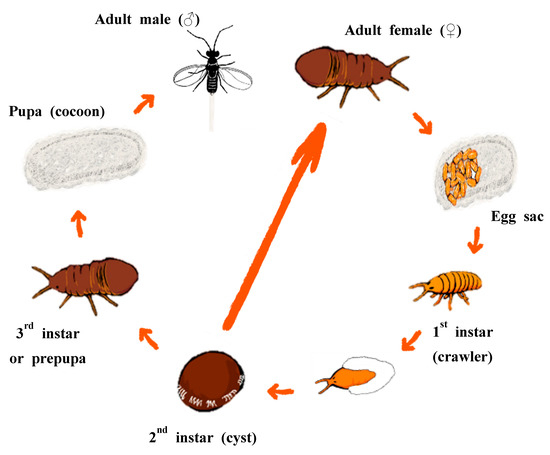
Figure 1.
General life cycle of Matsucoccus species.
The Japanese pine bast scale, Matsucoccus matsumurae, was described by Kuwana [8] as a new species on Japanese black pine (Pinus thunbergii Parl.) in Tokyo, Japan, and was mainly found in China, Japan, and Korea. In China, more than 70,000 km2 of pine forest damage by M. matsumurae had been reported each year between the 1970s–1980s despite attempts at chemical control [7,9].
In Korea, there had been no reports of significant damage by Matsucoccus matsumurae after the species was first found by Kanda [10], until a heavy infestation was detected on about 12,000 ha of Japanese black pine in the Southwestern coastal area of Korea [11]. This damage was found to be caused by a new species, M. thunbergianae Miller & Park [11], which was distinguished based on differences in morphological characteristics and in the number of generations from the congeners, M. matsumurae and M. resinosae Bean & Godwin. However, several studies implied that M. matsumurae, M. resinosae, and M. thunbergianae could be the same species. For example, the three species showed strong cross-attractiveness to sex pheromones [12,13], the main component of which was identical for the three species [14,15]. Finally, M. thunbergianae and M. resinosae were synonymized with M. matsumurae by Booth and Gullan [16], mainly based on their similarities in morphology and molecular sequences of 18S and 28S rDNA. However, M. thunbergianae is still considered a valid species in Korea [6,17,18,19] despite suggestions that the two species are synonymous, and an evaluation between M. thunbergianae collected from Korea and M. matsumurae was not possible due to the absence of DNA data from any available database.
In this study, we collected true Matsucoccus matsumurae from Fukuoka, Japan, and topotype materials of M. thunbergianae from Goheung, Korea, on the Japanese black pine to compare their morphologies and molecular sequences. To examine the spread of M. matsumurae, regional sampling was performed in Korea. Based on those data, we provide morphological and molecular characteristics of M. matsumurae and its current distribution in Korea.
2. Materials and Methods
2.1. Sample Collection
Eight populations of Matsucoccus sp. from Japan and Korea were sampled for morphological and molecular analyses (Figure 2; Table 1). To sample M. matsumurae, a population of Matsucoccus sp. (assumed to be M. matsumurae) on Pinus thunbergii was collected from Fukuoka in Japan. To sample M. thunbergianae, a population of Matsucoccus sp. (assumed to be topotype materials of M. thunbergianae) on P. thunbergii was collected from Goheung in Korea. For regional sampling in Korea, six populations of Matsucoccus sp. on P. densiflora or P. thunbergii were collected from Buan, Jeju, Pohang, Sacheon, Seoul, and Taean in Korea. Each population was preserved in 95% ethanol and stored at −20 °C for molecular analysis and morphological identification.
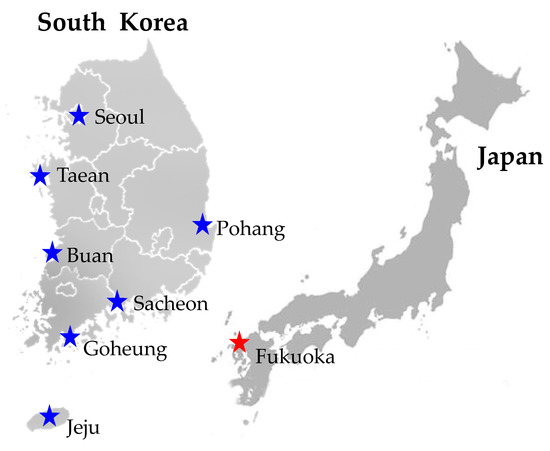
Figure 2.
Sampling localities of Matsucoccus sp. in Korea and Japan.

Table 1.
Collection data of samples used in this study (GPS coordinates; WGS84 coordinate system).
2.2. Morphological Identification
For morphological comparison, the adult females and males of Matsucoccus sp. from Fukuoka and Goheung were mounted on glass microscope slides using the methods of Danzig and Gavrilov-Zimin [20]. Morphological descriptions of Matsucoccus spp. in Foldi [5] and Morrison [21] were used to identify the adult females and males of slide-mounted specimens. Photomicrographs of the specimens were produced with a digital camera (Infinity3, Lumenera Corporation, Ottawa, Canada) mounted on a compound light microscope (DM 4000B, Leica Microsystems, Wetzlar, Germany). The slide specimens were deposited in either (i) the Insect Biosystematics Laboratory, Seoul National University, Korea (SNU), or (ii) Southern Forest Resources Research Center, National Institute of Forest Science (NIFS).
2.3. Molecular Analyses
Genomic DNA isolation was performed with the DNeasy Blood and Tissue kit (Qiagen, Inc., Dusseldorf, Germany) following the manufacturer’s protocols. For molecular comparison, we selected two nuclear ribosomal RNA genes (partial 18S and D2–D3 region of 28S). These two loci were amplified from the total DNA of the adult males of Matsucoccus sp. from Fukuoka and Goheung as well as other regions (Buan, Jeju, Pohang, Sacheon, Seoul and Taean). We designed primers based upon Margarodidae spp. 18S and 28S sequences from GenBank. Primer sequences used for the polymerase chain reaction (PCR) are given in Table 2. PCR was conducted with AccuPower PCR PreMix (Bioneer, Daejeon, Korea) in 20 ml including 0.4 μM of each primer, 20 μM dNTPs, 20 μM MgCl2, and 0.05 μg DNA template. The PCRs for 18S and 28S were performed under the following conditions: An initial denaturation step at 95 °C for 3 min, followed by 35 cycles at 95 °C for 30 s, 60 °C for 30 s, and 72 °C for 1 min and a final extraction step at 72 °C for 1 min. PCR products were visualized in 1.5% agarose gel electrophoresis. All amplified samples were purified using the QIAquick PCR purification kit (Qiagen, Inc., Dusseldorf, Germany) and sequenced using an automated sequencer (ABI Prism 3730 XL DNA Analyzer) at Macrogen Inc. (Seoul, Korea). Both strands of each sample were assembled and edited with SeqMan Pro ver. 7.1.0 (DNASTAR, Inc., Madison, WI, USA). The alignment was carried out using MEGAX [22], including sequences of Matsucoccus macrocicatrices Richards (used as reference, KF053072 for 18S; KF040573 for 28S) and Icerya purchasi Maskell (used as outgroup, AY426078 for 18S; KT199077 for 28S) downloaded from GenBank. The uncertain regions of sequences were removed, and 361 base pairs from 18S and 462 base pairs from 28S were used for the analyses. All sequences used in this study were deposited into GenBank under the accession number (from MH574783 to MH574790 for 28S; from MH574839 to MH574846 for 18S; Table 1). Genetic distances were measured in MEGAX using a neighbor-joining tree with the Kimura two-parameter model [23].

Table 2.
Primers used in this study.
3. Results
3.1. Morphological Comparison
The morphological characteristics of adult females and males of Matsucoccus thunbergianae from Korea are identical to those of M. matsumurae from Japan.
3.1.1. Adult Females
Based on the morphological information of Matsucoccus spp. in Foldi [5] (Figure 3), adult females of Matsucoccus sp. from Fukuoka, Japan, were identified as M. matsumurae. In addition, adult females of Matsucoccus sp. from Goheung, Korea, are morphologically similar to those of Fukuoka in eight morphological characteristics (Figure 4): (i) Nine-segmented antenna, with bases placed close together, and the scape and pedicel distinctly longer and wider than the associated flagellar segment (Figure 3A and Figure 4B); (ii) two pairs of thoracic spiracles, each with numerous tracheae (Figure 3I and Figure 4E,G); (iii) seven pairs of abdominal spiracles with a structure similar to that of thoracic spiracles (Figure 3G and Figure 4E,F); (iv) femur, tibia, and tarsus, each with a reticulated surface (Figure 3H); (v) a pair of ventral setae present on each abdominal segment III–VII (Figure 3F2 and Figure 4I); (vi) multilocular disc-pores each with 9–13 loculi and about 40–85 pores around the vulva (Figure 3E and Figure 4D); (vii) cicatrices present in transverse rows across abdominal segments III–VII, numbering 180–280 (Figure 3D and Figure 4H); (viii) bilocular tubular ducts in transverse rows on the head, thorax, and abdomen (Figure 3C and Figure 4C).
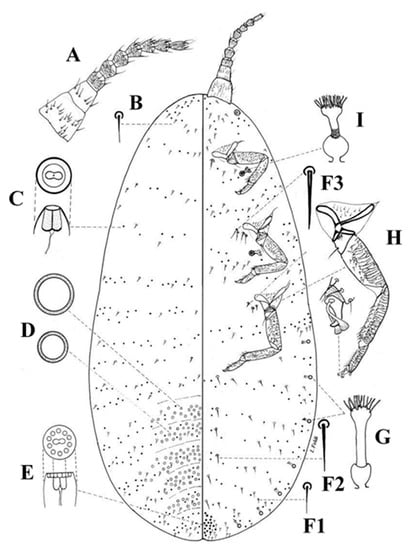
Figure 3.
Matsucoccus matsumurae (Kuwana, 1905), adult female, from Foldi [5]. A, antenna; B, dorsal seta; C, bilocular tubular duct; D, cicatrices; E, multilocular disc-pore; F1–3, ventral setae; G, abdominal spiracle; H, leg; I, thoracic spiracle. This figure was reproduced with permission of I. Foldi.
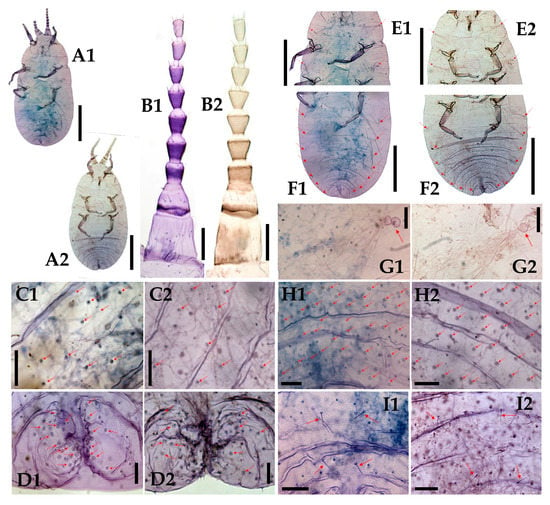
Figure 4.
Morphological comparison of the adult females from Goheung (first) and Fukuoka (second). A, bodies; B, antennae; C, bilocular tubular ducts; D, multilocular disc-pores; E, thoracic spiracles; F, abdominal spiracles; G, spiracles with numerous tracheae; H, cicatrices; I, ventral setae on abdomen. Scale lines for A, E, F = 1 mm; B = 100 μm; C, D, G, H, I = 50 μm.
3.1.2. Adult Males
Based on the morphological information of Matsucoccus spp. in Morrison [21] (Figure 5), adult males of Matsucoccus sp. from Fukuoka were identified as M. matsumurae. In addition, adult males of Matsucoccus sp. from Goheung were morphologically similar to those of Fukuoka, based on seven morphological characteristics (Figure 6): (i) Ten-segmented antenna, each with short and stout scape and pedicel, but slender and cylindrical in each flagellar segment (Figure 5F and Figure 6F); (ii) a head wider than it is long (transversely elongated), with antennal bases placed close together and large compound eyes (Figure 5C and Figure 6B); (iii) slender legs with reticulated tarsus and stout claws without denticles (Figure 5D and Figure 6G); (iv) wings with a reticulated costal complex that continues to the apex and two main veins extending from the wing base to its apex in the medial area with its under margin directed sharply downward on the basal area (Figure 5I–J and Figure 6C–D); (v) halteres are broadest at the apex, each with about six long and slender setae (Figure 5G and Figure 6H); (vi) abdomen with elongated multilocular tubular pores, clustered in a transversely ovoid area near the apex of the abdomen (Figure 5A and Figure 6I); (vii) the penis sheath is broad at the base and tapers to a rounded tip, while the aedeagus is slender, strongly curved, and protrudes beyond the apex of the penis sheath (Figure 5A and Figure 6E).
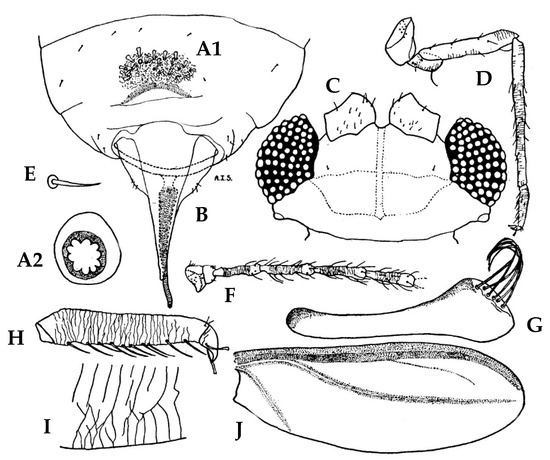
Figure 5.
Matsucoccus matsumurae (Kuwana, 1905), adult male, from Morison [21]. A1–2, multilocular tubular pores near apex of abdomen; B, genitalia (aedeagus and penis sheath); C, head; D, leg; E, ventral abdominal seta; F, antenna; G, halter; H, tarsus and claw; I, wing venation; J, wing.

Figure 6.
Morphological comparison of the adult males from Goheung (first) and Fukuoka (second). A, bodies; B, heads; C, wings; D, reticulated costal complexes; E, genitalia (aedeagus and penis sheath); F, antennae; G, legs, and tarsi and claws; H, halteres; I, multilocular tubular pores. Scale lines for A = 1 mm; B, E, G (bar beside tarsus and claw) = 100 μm; C = 0.5 mm; D = 10 μm; F = 500 μm; G (bar under entire leg) = 300 μm.
3.2. Molecular Comparison
The DNA sequences (18S rDNA and 28S rDNA) of Matsucoccus sp. from Korea showed identical or very small genetic distances compared to those of M. matsumurae from Japan. Each neighbor-joining tree and genetic distances of 18S and 28S sequences among the samples are presented in Figure 7 and Table 3 and Table 4, respectively.

Figure 7.
Neighbor-joining (NJ) tree analyses (using Kimura 2-parameter model) of seven regional populations of Matsucoccus sp. from Korea and M. matsumurae from Japan. A. 18S; B. 28S.

Table 3.
Genetic distances (%) of 18S sequences estimated by Neighbor-joining with Kimura-2 parameter model.

Table 4.
Genetic distances (%) of 28S sequences estimated by Neighbor-Joining with Kimura-2 parameter model.
4. Discussion
The original description of Matsucoccus thunbergianae has weak evidence to support it as a new species [11]. This new species was proposed based on the quantitative morphological features (especially in the adult males) and the number of generations per year, which might be considered as autapomorphic features that differentiated it from its congeners, such as M. matsumurae and M. resinosae. However, the characteristics of M. thunbergianae vary considerably according to environmental conditions (e.g., altitude, host plant, locality, and seasons), and all of the quantitative morphological traits have significant overlap among the three species. These points agree well with the opinions of Foldi [5] and Booth and Gullan [16], and are supported by the empirical tests of Boratynsky [24], Rieux [25], Ben-Dov [26], McClure et al. [27], and Miller and Park [11]. In this context, M. thunbergianae had been assigned an uncertain taxonomic status before it was synonymized with M. matsumurae [16]. As demonstrated by Booth & Gullan [16], the molecular and morphological features of the Matsucoccus species occurring on Pinus thunbergii and P. densiflora in Korea, which have been considered to be M. thunbergianae, are identical to those of M. matsumurae in this study.
The taxonomic validities of some species in the genus Matsucoccus have been controversial. Other congeners of M. matsumurae, such as M. boratynskii Bodenheimer & Neumark, M. dahuriensis Hu & Hu, M. gallicolus Morrison, M. liaoningensis Tang, M. pini (Green), and M. yunnanensis Ferris, have very similar morphology and differ in only a few characteristics [5,16]. Although we tentatively identified Matsucoccus species from Korea as M. matsumurae, further molecular and morphological studies with type specimens of those problematic species are needed, as the case research of Booth & Gullan [16] and this study both suggest that M. matsumurae, M. thunbergianae, and M. resinosae should be considered the same species.
The accurate identification of pest species is essential to establish an effective strategy of pest management. In this study supporting the results of Booth & Gullan [16], the Matsucoccus species occurring on Pinus thunbergii and P. densiflora in Korea should be recognized as M. matsumurae instead of M. thunbergianae. Until now, the control measures for species recognized as M. thunbergianae have been restrictively suggested in Korea; for example, chemical insecticides, such as fenitrothion 50EC and buprofezin 40SC [6], pheromone sticky traps [18], and yellow sticky traps [19]. On the other hand, biological control measures for M. matsumurae, such as entomopathogenic fungi, Lecanicillium fungicola strain HEB02, L. lecanii strain V3.4504 and V3.4505, Fusarium incarnatum-equiseti strain HEB01 [7,28], and natural enemies belonging to about 32 species [7], were proposed from China. In addition to this, studies were published on morphological changes in the antenna [29], and the wax glands and wax secretion [30] that might apply to the pest management of this species. Although Korean populations of M. matsumurae should be compared with the lineages from China using molecular tools, the results of this research will be useful to control the pests occurring on P. thunbergii in Korea.
In this study, Matsucoccus matsumurae occurring on Pinus thunbergii is reported for the first time from Jeju, Korea. We also observed the recent occurrence of M. matsumurae on P. densiflora from Seoul, although this area was recorded as one of the distributions of the species in Korea [31]. According to the results of Lim et al. [17], the occurrence of species under the name of M. thunbergianae was confirmed in all Southern coastal regions and some parts of Eastern and Western coastal regions, but it was not discovered in Chungcheongbuk-do, Daejeon, Jeju, or Seoul. In China, M. matsumurae also mainly damaged P. densiflora, which is widely distributed in Korea, along with P. thunbergii. Therefore, monitoring of this pest should be performed to investigate its exact occurrence and damage to Pinus species in the extensive regions that have previously been overlooked, especially in the Central and Northern inlands of Korea as well as Jeju.
The origin of Korean populations of Matsucoccus matsumurae is unclear, namely whether it is an indigenous species or an invasive species. Although there is no detailed information about the origin of host plants, Pinus densiflora and P. thunbergii, in the Korean Peninsula, both species are recognized as native Pinus species in Korea [32,33,34]. P. thunbergii, the main host plant of M. matsumurae, occurs mainly along Southern coastal areas of Korea [34]. According to Kim & Zsuffa [35], a number of P. thunbergii (ca. 308,624 trees) had been planted for reforestation (ca. 105,863 ha) of South Korea in the period between 1953 and 1990. Based on this evidence, the current outbreak of M. matsumurae could not be explained only with “introduction and sudden spread of invasive populations.” Moreover, the reproductive adult females of most scale insects, including M. matsumurae, have a sedentary lifestyle and very low dispersal ability (they are wingless) except for long-distance migration on the air currents as well as human-mediated transport [35,36]. To understand the possible circumstances concerning the outbreak of M. matsumurae in Korea, population genetic analyses using microsatellite markers or double digest restriction-site associated DNA sequencing (ddRAD-seq) are needed for various regional samples from China, Japan, and the USA, as well as Korea.
5. Conclusions
Based on the morphological and molecular evidence, our research corroborates the results of Booth & Gullan (2006) who synonymized Matsucoccus thunbergianae with M. matsumurae. These results imply the potential use of entomopathogenic fungi and natural enemies that were proposed from China to establish effective pest management in Korea. In addition, the occurrence of M. matsumurae is newly reported from Jeju, Korea in this study.
Author Contributions
J.C. and S.L. identified the pest based on morphological and molecular analyses and wrote the first draft of this paper; D.C. and D.-S.K. collected the materials used in this study and carried out the molecular experiments.
Funding
This research was supported by Korea Environment Industry & Technology Institute (KEITI) through Exotic Invasive Species Management Program, funded by Korea Ministry of Environment (MOE) (2018002270005).
Acknowledgments
We would like to acknowledge Imre Foldi (Département Systématique et Evolution, Muséum national d’Histoire naturelle, Paris, France) for giving us permission for reproducing his figure of Matsucoccus matsumurae. We also thank Penny J. Gullan (Research School of Biology, The Australian National University, Canberra, Australia) for asking Imre Foldi to get the permission.
Conflicts of Interest
The authors declare no conflict of interest.
References
- Cockerell, T.D.A. The Japanese Coccidae. Can. Entomol. 1909, 41, 55–56. [Google Scholar] [CrossRef]
- García Morales, M.; Denno, B.D.; Miller, D.R.; Miller, G.L.; Ben-Dov, Y.; Hardy, N.B. ScaleNet: A literature-Based Model of Scale Insect Biology and Systematics. Database 2016. Available online: http://scalenet.info (accessed on 1 October 2018).
- McKenzie, H.L.; Gill, L.S.; Ellis, D.E. The prescott scale (Matsucoccus vexillorum) and associated organisms that cause flagging injury to ponderosa pine in the southwest. J. Agric. Res. 1948, 76, 33–51. [Google Scholar]
- Furniss, R.L.; Carolin, V.M. Western Forest Insects; US Department of Agriculture, Forest Service: Washington, DC, USA, 1977; Volume 1339.
- Foldi, I. The Matsucoccidae in the Mediterranean basin with a world list of species (Hemiptera: Sternorrhyncha: Coccoidea). Annales de la Société Entomologique de France 2004, 40, 145–168. [Google Scholar] [CrossRef]
- Lim, E.; Kim, D.S.; Lee, S.M.; Choi, K.S.; Lee, D.W.; Chung, Y.J.; Park, C.G. Effect of fenitrothion on different life stages of black pine bast scale, Matsucoccus thunbergianae. J. Asia Pac. Entomol. 2013, 16, 55–59. [Google Scholar] [CrossRef]
- Liu, W.; Xie, Y.; Yang, Q.; Xue, J.; Tian, F. New Research on Matsucoccus matsumurae (Kuwana) (Hemiptera: Matsucoccidae) in China. Acta Zool. Bulg. 2014, 6, 95–102. [Google Scholar]
- Kuwana, S.I. A new Xylococcus in Japan. Insect World 1905, 9, 91–95. [Google Scholar]
- Liu, W.; Xie, Y.; Xue, J.; Zhang, Y.; Tian, F.; Yang, Q.; Wu, J.; Tang, X.; Geng, Y.; Zhang, Y.; et al. Morphology, behavior and natural enemies of Matsucoccus matsumurae (Homoptera: Matsucoccidae) during development. Sci. Silvae Sin. 2015, 51, 69–83. [Google Scholar]
- Kanda, S. Studies on Coccidae from Corea. Insect World 1941, 45, 296–303. [Google Scholar]
- Miller, D.R.; Park, S.C. A new species of Matsucoccus (Homoptera: Coccoidea: Margarodidae) from Korea. Korean J. Plant Prot. 1987, 26, 49–62. [Google Scholar]
- Young, B.L.; Miller, D.R.; McClure, M.S. Attractivity of the female sex pheromone of Chinese Matsucoccus matsumurae (Kuwana) to males of M. matsumurae in Japan and to males of M. resinosae Bean and Godwin in the United States (Margarodidae, Coccoidea, Homoptera). Contrib. Shanghai Inst. Entomol. 1984, 1984, 1–20. [Google Scholar]
- Park, S.C.; West, J.R.; Abrahamson, L.P.; Lanier, G.N.; Silverstein, R.M. Cross-attraction between two species of Matsucoccus. J. Chem. Ecol. 1986, 12, 609–617. [Google Scholar] [CrossRef] [PubMed]
- Lanier, G.N.; Qi, Y.T.; West, J.R.; Park, S.C.; Webster, F.X.; Silverstein, R.M. Identification of the sex pheromone of three Matsucoccus pine bast scales. J. Chem. Ecol. 1989, 15, 1645–1659. [Google Scholar] [CrossRef] [PubMed]
- Hibbard, B.E.; Lanier, G.N.; Parks, S.C.; Qi, Y.T.; Webster, F.X.; Silverstein, R.M. Laboratory and field tests with the synthetic sex pheromone of three Matsucoccus pine bast scales. J. Chem. Ecol. 1991, 17, 89–102. [Google Scholar] [CrossRef] [PubMed]
- Booth, J.M.; Gullan, P.J. Synonymy of three pestiferous Matsucoccus scale insects (Hemiptera: Coccoidea: Matsucoccidae) based on morphological and molecular evidence. Proc. Entomol. Soc. Wash. 2006, 108, 749–760. [Google Scholar]
- Lim, E.G.; Lee, S.M.; Kim, D.S.; Kim, J.B.; Lee, S.H.; Choi, K.S.; Park, C.G.; Lee, D.W. The spread of black pine bast scale, Matsucoccus thunbergianae (Hemiptera: Margarodidae) in Korea. Korean J. Appl. Entomol. 2012, 51, 59–65. [Google Scholar] [CrossRef]
- Kim, J.; Kim, D.S.; Matsuyama, S.; Lee, S.M.; Lee, S.C.; Park, I.K. Development of a pheromone trap for monitor black pine bast scale, Matsucoccus thunbergianae (Hemiptera: Margarodidae). J. Asia Pac. Entomol. 2016, 19, 899–902. [Google Scholar] [CrossRef]
- Lee, C.J.; Kim, D.S.; Chung, Y.H.; Lee, S.M.; Lee, S.J.; Lee, D.W. Monitoring of black pine bast scale, Matsucoccus thunbergianae (Homoptera: Margarodidae) using yellow sticky trap. Korean J. Appl. Entomol. 2018, 57, 143–149. [Google Scholar]
- Danzig, E.M.; Gavrilov-Zimin, I.A. Palaearctic Mealybugs (Homoptera: Coccinea: Pseudococcidae), Part 1: Subfamily Phenacoccinae; Russian Academy of Sciences, Zoological Institute: St. Petersburg, Russia, 2014. [Google Scholar]
- Morrison, H. A Classification of the Higher Groups and Genera of the Coccid Family Margarodidae (No. 52); US Department of Agriculture Technical Bulletin: Washington, DC, USA, 1928.
- Kumar, S.; Stecher, G.; Li, M.; Knyaz, C.; Tamura, K. MEGA X: Molecular evolutionary genetics analysis across computing platforms. Mol. Biol. Evol. 2018, 35, 1547–1549. [Google Scholar] [CrossRef]
- Kimura, M. A simple method for estimating evolutionary rates of base substitutions through comparative studies of nucleotide sequences. J. Mol. Evol. 1980, 16, 111–120. [Google Scholar] [CrossRef]
- Boratynski, K.L. Matsucoccus pini (Green, 1925) (Homoptera, Coccoidea: Margarodidae): Bionomics and external anatomy with reference to the variability of some taxonomic characters. Trans. R. Entomol. Soc. Lond. 1952, 103, 285–326. [Google Scholar] [CrossRef]
- Rieux, R. Matsucoccus pini Green (1925) (Homoptera, Margarodidae) dans le Sud-Est de la France. Variations intraspécifiques. Comparaison avec des espèces les plus proches. Annales de Zoologie Ecologie Animale 1976, 8, 231–263. [Google Scholar]
- Ben-Dov, Y. Redescription of Matsucoccus josephi Bodenheimer and Harpaz (Homoptera: Coccoidea: Margarodidae). Isr. J. Entomol. 1981, 15, 35–51. [Google Scholar]
- McClure, M.S. Temperature and host availability affect the distribution of Matsucoccus matsumurae (Kuwana) (Homoptera: Margarodidae) in Asia and North America. Ann. Entomol. Soc. Am. 1983, 76, 761–765. [Google Scholar] [CrossRef]
- Wang, X.; Xie, Y.; Zhang, Y.; Liu, W.; Wu, J. The structure and morphogenic changes of antennae of Matsucoccus matsumurae (Hemiptera: Coccoidea: Matsucoccidae) in different instars. Arthropod Struct. Dev. 2016, 45, 281–293. [Google Scholar] [CrossRef] [PubMed]
- Xie, Y.; Tian, F.; Liu, W.; Zhang, Y.; Xue, J.; Zhao, Y.; Wu, J. The wax glands and wax secretion of Matsucoccus matsumurae at different development stages. Arthropod Struct. Dev. 2014, 43, 193–204. [Google Scholar] [CrossRef] [PubMed]
- Paik, W.H. Illustrated Flora and Fauna of Korea. Insecta (VIl); No. 22; Min. Education: Seoul, Korea, 1978.
- Kong, W.S. Species composition and distribution of native Korean conifers. J. Korean Geogr. Soc. 2004, 39, 528–543. [Google Scholar]
- Kong, W.S. Biogeography of native Korean Pinaceae. J. Korean Geogr. Soc. 2006, 41, 73–93. [Google Scholar]
- Kong, W.S.; Lee, S.G.; Park, H.N.; Lee, Y.M.; Oh, S.H. Time-spatial distribution of Pinus in the Korean Peninsula. Quat. Int. 2014, 344, 43–52. [Google Scholar] [CrossRef]
- Kim, K.H.; Zsuffa, L. Reforestation of South Korea: The history and analysis of a unique case in forest tree improvement and forestry. For. Chron. 1994, 70, 58–64. [Google Scholar] [CrossRef]
- Gullan, P.J.; Kosztarab, M.P. Adaptations in scale insects. Annu. Rev. Entomol. 1997, 42, 23–50. [Google Scholar] [CrossRef]
- Kondo, T.; Gullan, P.J.; Williams, D.J. Coccidology. The study of scale insects (Hemiptera: Sternorrhyncha: Coccoidea). Ciencia y Tecnología Agropecuaria 2008, 9, 55–61. [Google Scholar] [CrossRef]
© 2019 by the authors. Licensee MDPI, Basel, Switzerland. This article is an open access article distributed under the terms and conditions of the Creative Commons Attribution (CC BY) license (http://creativecommons.org/licenses/by/4.0/).